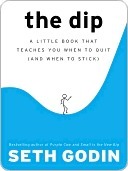More on this book
Community
Kindle Notes & Highlights
by
Seth Godin
Read between
May 6 - May 9, 2023
Just about everything you learned in school about life is wrong, but the wrongest thing might very well be this: Being well rounded is the secret to success.
Strategic quitting is the secret of successful organizations. Reactive quitting and serial quitting are the bane of those that strive (and fail) to get what they want. And most people do just that. They quit when it’s painful and stick when they can’t be bothered to quit.
The Dip is the long slog between starting and mastery. A long slog that’s actually a shortcut, because it gets you where you want to go faster than any other path.
Scarcity, as we’ve seen, is the secret to value. If there wasn’t a Dip, there’d be no scarcity.
That’s it. Two big curves (a bonus, the Cliff, follows). Stick with the Dips that are likely to pan out, and quit the Cul-de-Sacs to focus your resources. That’s it.
The Dip creates scarcity; scarcity creates value.
The Cul-de-Sac and the Cliff Are the Curves That Lead to Failure
If you find yourself facing either of these two curves, you need to quit. Not soon, but right now. The biggest obstacle to success in life, as far as I can tell, is our inability to quit these curves soon enough.
In a competitive world, adversity is your ally. The harder it gets, the better chance you have of insulating yourself from the competition. If that adversity also causes you to quit, though, it’s all for nothing.
And yet the real success goes to those who obsess. The focus that leads you through the Dip to the other side is rewarded by a marketplace in search of the best in the world.
A woodpecker can tap twenty times on a thousand trees and get nowhere, but stay busy. Or he can tap twenty-thousand times on one tree and get dinner.
Quitting is difficult. Quitting requires you to acknowledge that you’re never going to be #1 in the world. At least not at this. So it’s easier just to put it off, not admit it, settle for mediocre. What a waste.
It’s human nature to quit when it hurts. But it’s that reflex that creates scarcity.
The challenge is simple: Quitting when you hit the Dip is a bad idea. If the journey you started was worth doing, then quitting when you hit the Dip just wastes the time you’ve already invested.
Simple: If you can’t make it through the Dip, don’t start. If you can embrace that simple rule, you’ll be a lot choosier about which journeys you start.
The next time you catch yourself being average when you feel like quitting, realize that you have only two good choices: Quit or be exceptional. Average is for losers.
Serial Quitters Spend a Lot of Time in Line
Selling is about a transference of emotion, not a presentation of facts.
No, the opposite of quitting is rededication. The opposite of quitting is an invigorated new strategy designed to break the problem apart.
Short-term pain has more impact on most people than long-term benefits do, which is why it’s so important for you to amplify the long-term benefits of not quitting. You need to remind yourself of life at the other end of the Dip because it’s easier to overcome the pain of yet another unsuccessful cold call if the reality of a successful sales career is more concrete.
Persistent people are able to visualize the idea of light at the end of the tunnel when others can’t see it.
At the same time, the smartest people are realistic about not imagining light when there isn’t any.
Winners understand that taking that pain now prevents a lot more pain later.
Failing, on the other hand, means that your dream is over. Failing happens when you give up, when there are no other options, or when you quit so often that you’ve used up all your time and resources.
“Never quit something with great long-term potential just because you can’t deal with the stress of the moment.”
If you’re trying to succeed in a job or a relationship or at a task, you’re either moving forward, falling behind, or standing still. There are only three choices.


